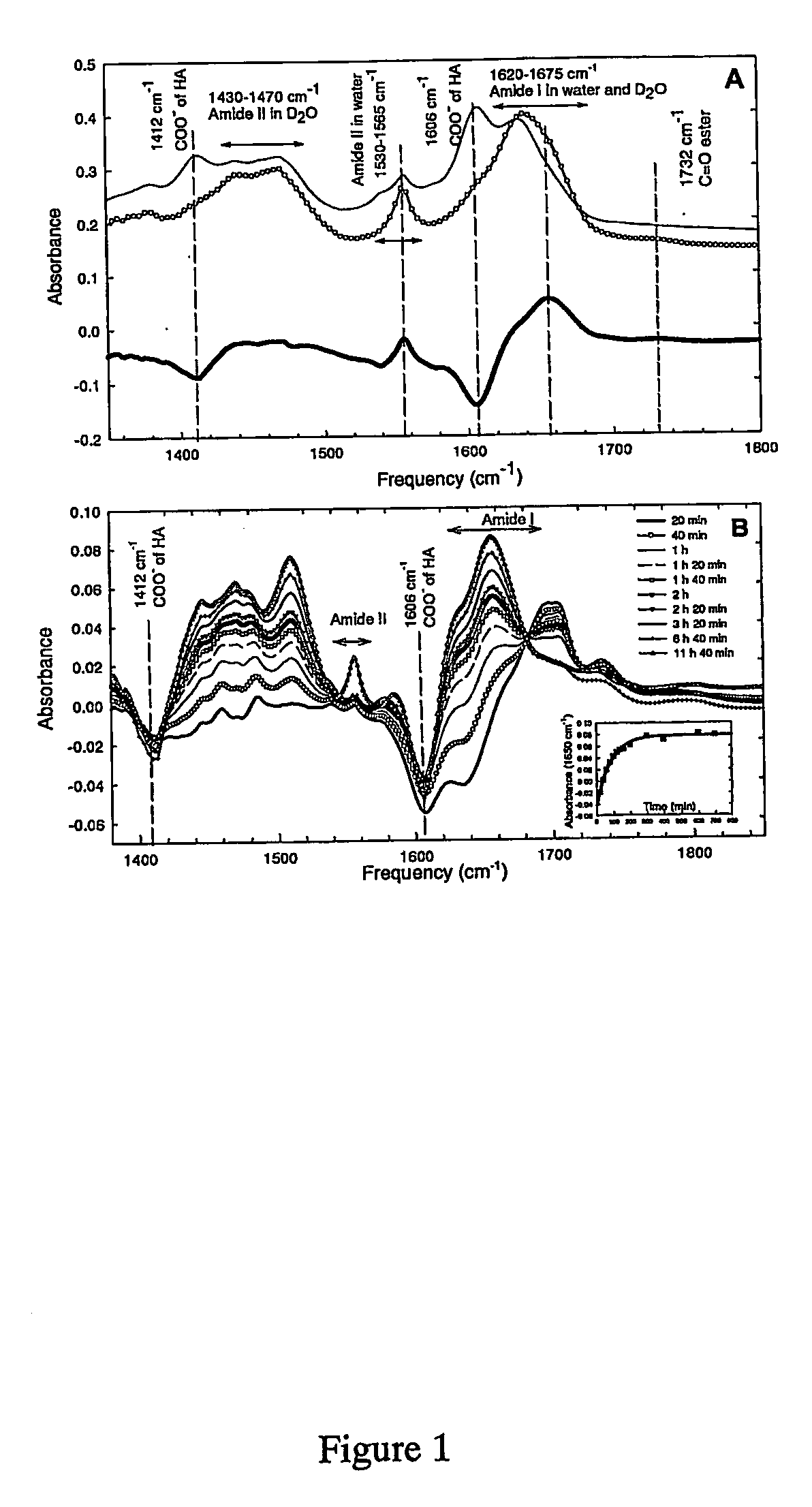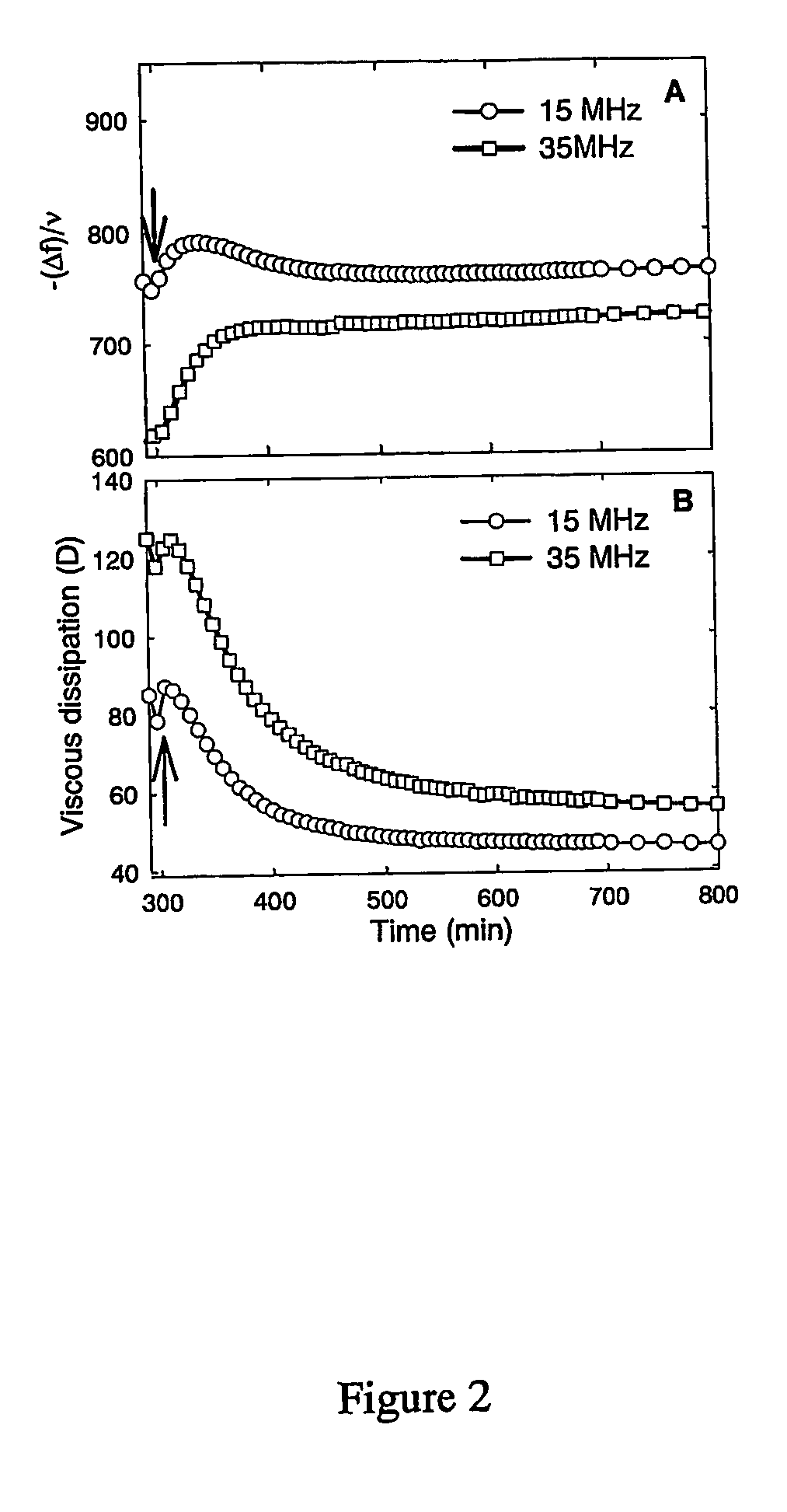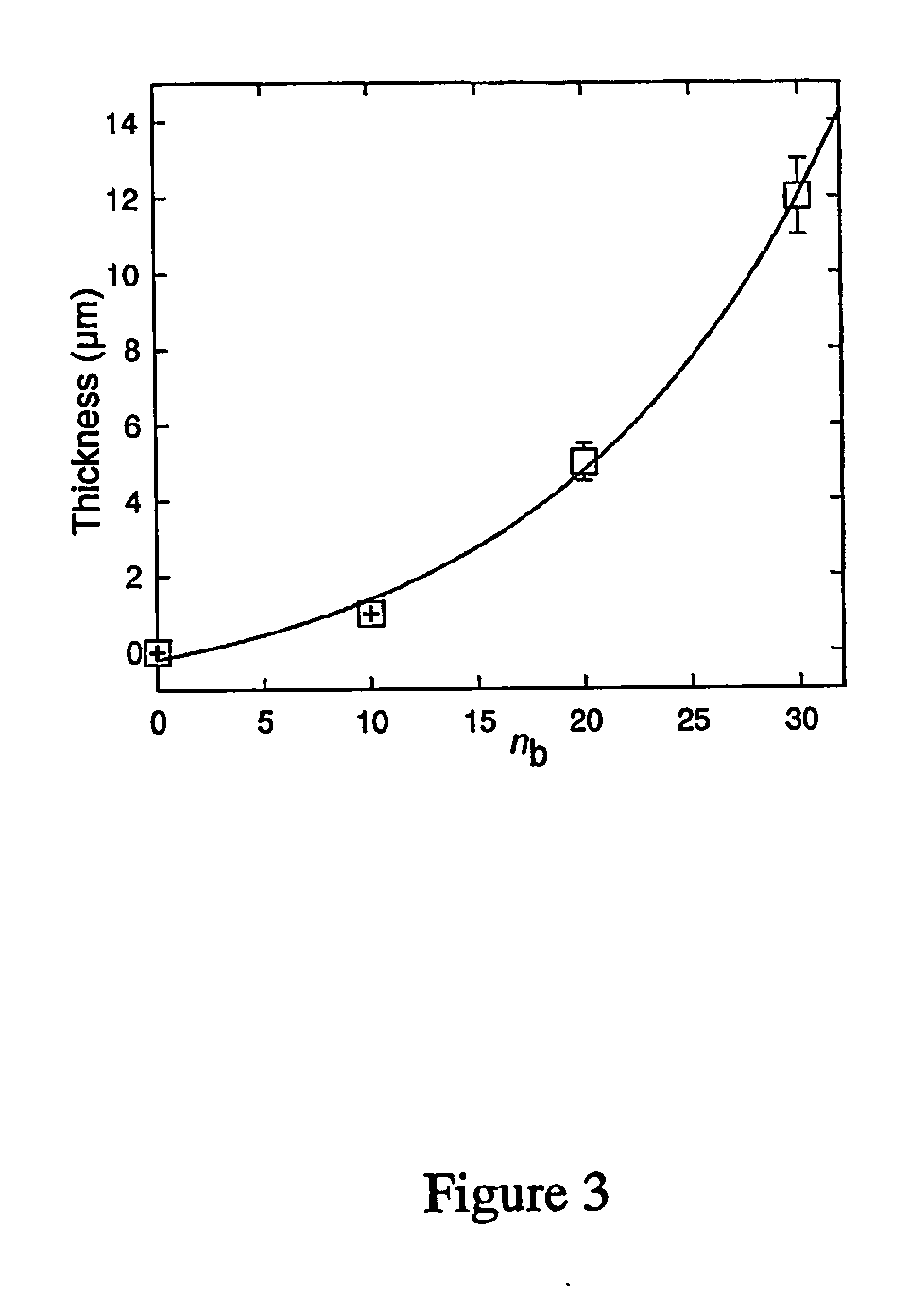Method for preparing crosslinked polyelectrolyte multilayer films
a technology of crosslinked polyelectrolyte and multi-layer film, which is applied in the field of methods for preparing crosslinked polyelectrolyte multi-layer film, can solve the problems of non-controlled modification of film structure, inability to meet the requirements of the application, so as to increase the resistance to a certain medium and maintain stability or positional integrity.
- Summary
- Abstract
- Description
- Claims
- Application Information
AI Technical Summary
Benefits of technology
Problems solved by technology
Method used
Image
Examples
example 1
[0109] Materials and Methods.
[0110] Polyelectrolyte solutions. The preparation of solutions of poly(L-lysine) (PLL, 30 kDa, Sigma, France), hyaluronan (HA, 400 kDa, Bioiberica, Spain) and the buildup of (PLL / HA)i films was previously described in Picart, C.; Lavalle, P.; Hubert, P.; Cuisinier, F. J. G.; Decher, G.; P, S.; Voegel, J. C. Langmuir 2001, 17, 7414-7424.
[0111] PLL and HA were dissolved at 1 mg / mL in 0.15 M NaCl at pH 6-6.5. During the film construction, all the rinsing steps were performed with an aqueous solution containing 0.15 M NaCl at pH 6-6.5. Fluorescein isothiocyanate labeled PLL (PLL-FITC), 1-ethyl-3-(3-dimethylaminopropyl)carbodiimide (EDC), N-Hydroxysulfo-succinimide (sulfo-NHS), and hyaluronidase (Type I) were purchased from Sigma-Aldrich and used without any purification.
[0112] Chemical cross-linking of the films by EDC / NHS. Fresh solutions of EDC (400 mM) and sulfo-NHS (100 mM) were prepared in 0.15 M NaCl solution at pH 5.5. The coupling chemistry is bas...
example 2
[0138] Materials and Methods.
[0139] Cells Cultures
[0140] THP-1 macrophages. Human promonecytic THP-1 cells (American Type Culture Collection) were maintained in Roswell Parc Memorial Institute (RPMI) 1640 medium containing 10% fetal bovine serum (FBS), 2 mM L-glutamine and antibiotics (all from Life Technologies, Paisley, UK). Differentiated THP-1 cells were obtained by treatment with 5 nM TPA for two days and then starved overnight in 0.5% FBS-RPMI in the presence of 5 nM TPA before stimulation (Jessel N, Atalar F, Lavalle P, Mutterer J, Decher G, Schaaf P, Voegel J C, Ogier G. 2003. Bioactive coatings based on polyelectrolyte multilayer architecture functionalised by embedded proteins. Adv. Mater. 15(9):692-695).
[0141] Primary Cells
[0142] Chondrocytes proliferation. Chondrocytes were isolated from femoral head caps and cultured as previously described (Miralles G, Baudoin R, Dumas D, Baptiste D, Hubert P, Stoltz J F, Dellacherie E, Mainard D, Netter P, Payan E. 2001. Sodium al...
example 3
[0156] 3.1 (PLL / PGA) Films
[0157] Material and Methods.
[0158] Polyelectrolyte solutions. Poly(L-lysine) (PLL, 30 kDa, Sigma, France) and poly(L-glutamic) acid (PGA, 55 kDa, Sigma, France) (PLL / PGA) films were built in Hepes buffer (50 mM Hepes), containing 0.15 M NaCl at 1 mg / mL (pH=7.4). During the film construction all the rinsing steps were performed in the same buffer. 1-ethyl-3-(3-dimethylaminopropyl) carbodiimide (EDC), N-Hydroxysulfo-succinimide (sulfo-NHS) were purchased from Sigma-Aldrich and used without any purification. The 15 amino acid peptide that contained a —RGD-(Arg-Gly-Asp) sequence (CGPKGDRGDAGPKGA) derived from collagen 1 was obtained from Neosystem (Strasbourg, France) and purified by high-performance liquid chromatography. Amino-ethylmaleimide (NH2EtMal) was prepared according to previously published procedures (Boeckler C, Dautel D, Schelte P, Frisch B, Wachsmann D, Klein J P, Schuber F. 1999. Design of highly immunogenic liposomal constructs combining struc...
PUM
| Property | Measurement | Unit |
|---|---|---|
| temperature | aaaaa | aaaaa |
| thickness | aaaaa | aaaaa |
| thickness | aaaaa | aaaaa |
Abstract
Description
Claims
Application Information
 Login to View More
Login to View More - R&D
- Intellectual Property
- Life Sciences
- Materials
- Tech Scout
- Unparalleled Data Quality
- Higher Quality Content
- 60% Fewer Hallucinations
Browse by: Latest US Patents, China's latest patents, Technical Efficacy Thesaurus, Application Domain, Technology Topic, Popular Technical Reports.
© 2025 PatSnap. All rights reserved.Legal|Privacy policy|Modern Slavery Act Transparency Statement|Sitemap|About US| Contact US: help@patsnap.com



